The Foresight for Food System Transformation (FoSTr) programme, led by Foresight4Food, is now two years into its journey of helping shape more sustainable, inclusive, and resilient food systems. With increasing uncertainties affecting global food systems—from climate change to economic challenges—the need for foresight and scenario analysis has never been more critical.

Running from 2022 to 2025, the programme is funded by the Dutch Ministry of Foreign Affairs through an IFAD grant. Based on the approach of the Foresight Framework, the programme focuses on supporting four key countries: Bangladesh, Jordan, Kenya, and Uganda.
Since its commencement, we have seen tremendous strides in advancing the key objectives of the FoSTr programme across multiple fronts. This blog highlights the progress and impact of the FoSTr programme and the exciting path ahead.
In-Country Impact: Strengthening Foresight Processes
In each of the focus countries, national foresight processes gained momentum, engaging a wide range of stakeholders, including government bodies, research institutions, and community representatives. In total, 403 individual stakeholders participated in in-country workshops across the four countries, contributing to meaningful conversations about the future of food systems.
Here is a quick overview of FoSTr programme’s progress in each of the focus countries:
Bangladesh – Strong government buy-in has been established, with collaboration from the Ministry of Food and other key players, all contributing to the national food system transformation agenda.
Jordan – Partnerships with the Ministry of Agriculture and other government entities have positioned FoSTr as a key advisor, particularly in driving forward the work of the newly established Food Security Council.
Kenya – Foresight analysis has been particularly active at both the national and county levels, with significant involvement from the Nakuru and Marsabit County governments.
Uganda – FoSTr is closely aligned with the Uganda Planning Authority, helping develop foresight tools for future food system planning.






Global Collaboration: Building a Brokering Hub
On a global scale, FoSTr expanded its network of foresight and food systems practitioners, deepening collaboration across organizations like the Forum for Agricultural Research in Africa (FARA), the Global Alliance for Improved Nutrition (GAIN) in Bangladesh, and a number of renowned research institutes in the focus countries.
The work of FoSTr programme was very well-received at the 4th Global Foresight4Food Workshop in Dhaka, where more than 120 foresight practitioners from Asia, Africa, and Europe gathered to share insights on foresight methodologies and food system challenges.
Read also:
Using Foresight to Re-imagine the Future of Food Systems: Foresight4Food holds its 4th Global Meeting – by Jim Woodhill
In a highly interactive week, participants engaged in a masterclass on foresight approaches, shared their experiences and lessons, heard from thought-leaders on food systems and foresight, and identified ways of strengthening foresight practice in their own countries and regions…
A Start to the Foresight Process: Food Systems Maps
As a part of the foresight process, there is a need to have a collective understanding of the food system in different contexts. Hence, the Foresight4Food FoSTr team in collaboration with our facilitators and research partners in each focus country, created comprehensive food systems reports mapping the dynamics, trends, drivers, and activities within the food system.
These Food System Maps offer an initial snapshot of the current food system status in the focus countries and are intended to inform a more comprehensive foresight process. As the dynamics, trends, drivers, and activities within the food system continually change, these reports welcome ongoing reflection and discussion.
Knowledge Base
FoSTr also played a vital part in strengthening the Foresight4Food Resource Portal, which provides access to Foresight Studies, key data around Food System Drivers and Outcomes, a database of Foresight Initiatives, and other academic literature that helps food systems practitioners develop better Foresight Models.
The Foresight4Food Resource Portal is regularly updated with the latest research and emerging studies as well as products and resources that come out of different programme activities.
Read also:
The Complexity of Global Drivers of Food System Transformation – by Bhawana Gupta
The global food system needs to be transformed. It needs to deliver better health and improved livelihoods while protecting the environment and minimizing negative social impacts. However, there are many interconnected factors playing a role. Food Systems are complex…
Overcoming Challenges
Like any ambitious programme, FoSTr encountered its share of challenges. These included navigating political instability in some focus countries. Meanwhile, navigating the political economy of food systems—especially where entrenched power dynamics and vested interests are at play—required FoSTr to strike a delicate balance between supporting ongoing policy processes and introducing more transformative ideas for change.
The Way Forward
As the Foresight4Food FoSTr programme enters its third and final year, several key objectives will guide the remaining activities:
Brokering Foresight Processes: Continue to build connections with national stakeholders and existing initiatives, ensuring that foresight insights are integrated into policy-making and planning processes.
Capacity Building: Organize intensive face-to-face training workshops to further enhance foresight facilitation skills and broaden participation from underrepresented groups, including the private sector and youth.
Scenario Analysis and Policy Recommendations: Complete the ongoing scenario analyses and translate these into clear policy recommendations that will guide national food system transformation agendas.
Sustaining Momentum Beyond 2025: Establish sustainable communities of practice that can continue to drive foresight activities beyond the programme’s official end.
Conclusion: A Transformative Journey
In an era where global food systems are under immense pressure due to climate change, population growth, and shifting socio-economic landscapes, forward-thinking approaches are critical to ensuring food security and sustainability.
The Foresight4Food FoSTr programme has made significant headway in its mission to advance food system foresight processes in Bangladesh, Jordan, Kenya, and Uganda while building a broader global network of foresight practitioners. As we look ahead to the final year, the focus will be on translating foresight insights into action, empowering national stakeholders, and ensuring that the work of FoSTr continues to have a lasting impact on food systems worldwide.
Bonus: FoSTr Facilitators Insights
As the Foresight4Food FoSTr programme continues to foster systemic change in global food systems, the programme facilitators will be sharing their observations on the work and progress of FoSTr programme in their respective countries through insightful blogs. Watch this space and our social media channels for more updates.
By Bhawana Gupta, Monika Zurek, and John Ingram
In a world facing unprecedented uncertainties, the futureproofing of policies has become more crucial than ever. Foresight tools and methods, widely used across various sectors, play a pivotal role in supporting decision-making by providing an evidence base for assessing challenges, prioritising issues, sense-making, preparing a targeted action plan, and conducting risk assessments.
However, the challenge often lies in aligning these foresight activities with the policymaking cycle to create coherent, impactful policies. This blog provides a glimpse of an ongoing Foresight4Food study in Bangladesh, Jordan, Kenya and Uganda under the Foresight4Food FoSTr programme that explores how foresight tools can be systematically integrated into the policymaking cycle to enhance their utility and contribute to better policy outcomes.
The gap in current practices
Despite the widespread use of foresight methods, there is often a lack of clarity on how their outcomes can feed into decision-making. The foresight activity is frequently not recontextualized for the specific policy problem at hand. This disconnect poses a significant challenge, as the integration of foresight into the policymaking cycle is crucial for developing more resilient and future-proof policies. The goal is to bridge this gap by providing evidence on the most useful foresight tools and methods for each part of the policymaking cycle.
When foresight is integrated into the policymaking cycle, it ensures that future-oriented thinking is consistently applied throughout the policy development process, leading to more coherent and effective policies.
Read also:
The Complexity of Global Drivers of Food System Transformation – by Bhawana Gupta
The global food system needs to be transformed. It needs to deliver better health and improved livelihoods while protecting the environment and minimizing negative social impacts. However, there are many interconnected factors playing a role. Food Systems are complex…
Importance of linking foresight with the policy cycle
Integrating foresight processes with the policy cycle is essential to institutionalize foresight and enhance its usability at national and local levels. Institutionalizing foresight ensures that these methods are systematically applied, enabling policymakers to anticipate and prepare for future challenges effectively. It also ensures inclusiveness and rigour of the policy-making process.
Such work can draw on the experience in several high-income countries have successfully institutionalised foresight within their policymaking structures, demonstrating the benefits of this approach. Some examples are:
- Finland: Finland has a well-established foresight system integrated into its national policy framework. The Finnish Government Foresight Group coordinates foresight activities across various sectors, ensuring that long-term trends and future scenarios are considered in policymaking.
- Singapore: The Centre for Strategic Futures (CSF) in Singapore plays a key role in incorporating foresight into government planning. CSF conducts scenario planning and horizon scanning to support strategic decision-making and policy development.
- United Kingdom: The UK Government Office for Science runs the Foresight Programme, which explores future challenges and opportunities. This programme provides evidence-based insights to inform policy decisions across different government departments.
But what led to the establishment of foresight institutions as an integral part of the policy-making bodies in these countries? It’s the awareness, capacity building and the demand for foresight knowledge which have been crucial. Foresight4Food is playing a major role in its case study middle- and low-income countries in instigating the adoption of foresight across all levels of decision-making processes.
How our research is guiding foresight in middle and low-income countries
While high-income countries have made significant strides in institutionalising foresight, it is equally important for middle- and low-income countries to adopt these practices. The challenges faced by these countries, such as rapid urbanization, climate change, and economic volatility require proactive and informed policy responses.
Research on the appropriate foresight methods for different policymaking stages can significantly aid in institutionalising foresight in such countries by ensuring targeted application and resource efficiency, thus maximising the value of foresight activities. By pinpointing specific methods for each policy stage, governments can allocate limited resources more effectively, avoiding a one-size-fits-all approach. This tailored research provides a clear framework for capacity building, enabling policymakers to apply foresight methods appropriately across different policy stages. Demonstrating the practical benefits of specific methods enhances decision-making, supports institutional integration, and fosters a culture of foresight within government institutions.

Furthermore, it ensures policy coherence and continuity, establishing standardized foresight practices that maintain consistency even amidst political and administrative changes, ultimately promoting the institutionalisation of foresight in these countries.
Understanding the policymaking cycle
Institutional decision-making follows a structured sequential process known as the policymaking cycle, which guides actions and outcomes through distinct stages. Governments worldwide have adapted this cycle to develop new policies or reform existing ones. This model provides a clear and organized way to understand and analyse how policies are developed and executed.
However, in reality, the policymaking process is rarely this straightforward. It is typically non-linear, iterative, and influenced by a multitude of factors including political dynamics, stakeholder interests, and unexpected events. Despite this complexity, the policy cycle remains an important framework for several reasons but most importantly the principles underlying the policy cycle—such as systematic analysis, stakeholder engagement, and evidence-based decision-making—remain relevant. These principles provide a foundation for effective policymaking, guiding policymakers in navigating the complexities and uncertainties of the real world.
Understanding the policy-cycle stages is the first step, as it allows foresight practitioners to identify where future-oriented insights can be most impactful, ensuring that long-term considerations and potential future scenarios are effectively embedded into the policymaking process. This structured approach enhances the relevance and applicability of foresight outcomes, leading to more robust and resilient policies.
There are many examples of these policy cycles that have been developed and adapted but the essence remains consistent. Typically, it includes stages such as issue identification, policy identification, policy adoption and implementation, and lastly policy monitoring and evaluation. This cycle serves as a valuable model to explore which foresight tools/methods can generate insights needed for processing in the policy cycle.
Mapping foresight methods to policymaking stages
Foresight4Food researchers mapped more than 50 foresight tools and methods that have been implemented for a range of purposes. Sometimes the same tool was used for different purposes, which changes the way the tool was used and applied. Foresight methods can therefore serve various purposes at different stages of the policymaking process.
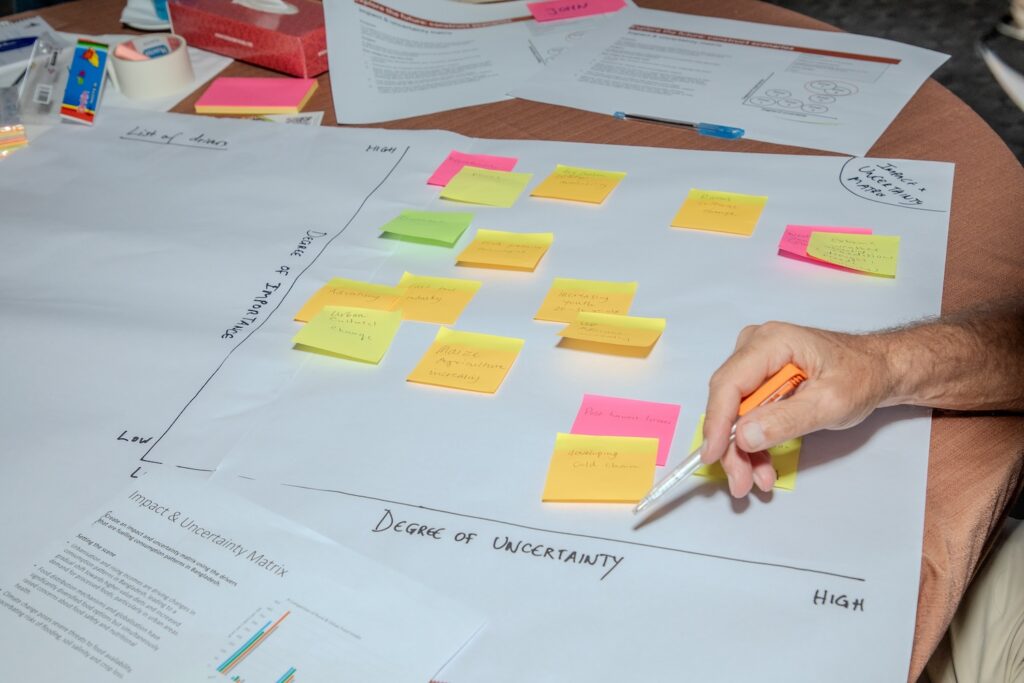


This study highlights several models of the policymaking cycle and how foresight tools can be mapped onto these stages. For example:
- Agenda Setting: Foresight can generate information on challenges, drivers of change, and options for tackling problems, which directs policymakers to develop a policy concept and contextualize the emerging problem.
- Policy Formulation: Scenario planning and trend analysis can help in developing policy options and assessing their potential impacts.
- Policy adoption and implementation: Participatory approaches and Delphi methods can facilitate inclusive participation and build consensus on the preferred policy option. Horizon scanning and risk assessments can enhance policy implementation by raising awareness of future changes and building networks for understanding visions among stakeholders.
- Monitoring and evaluation: Backcasting and impact assessments can be used to evaluate the effectiveness of implemented policies and provide a basis for future decision-making.
In conclusion, integrating foresight tools into the policymaking cycle is crucial for developing more resilient, future-proof policies. While high-income countries have demonstrated the value of institutionalizing foresight, it is vital for middle- and low-income countries to also adopt these practices to address their unique challenges and opportunities. By systematically linking foresight with the policy cycle, policymakers can create more informed, adaptable, and sustainable policies, ultimately contributing to better outcomes for society.
By Jim Woodhill, Lead Foresight4Food Initiative
Last week, I had the wonderful opportunity to support a regional training workshop on foresight for systems change in Nepal, in collaboration with the International Centre for Integrated Mountain Development (ICIMOD).
The workshop brought together a group of 35 development practitioners from across the Hindu Kush Himalaya region, including participants from Nepal, Bangladesh, Bhutan, India, and Pakistan. The focus was on how to use foresight to help tackle the big regional issues of climate adaptation, creating diversified and resilient livelihoods in mountain areas, migration, and disaster preparedness.
ICIMOD invited Foresight4Food to collaborate in facilitating the training, using Foresight4Food’s Framework of foresight for systems change following the organization’s participation in a similar leaders capacity development workshop held in Africa in 2023 (see report and video here) and Foresight4Food’s 4th Global Meeting in Bangladesh.


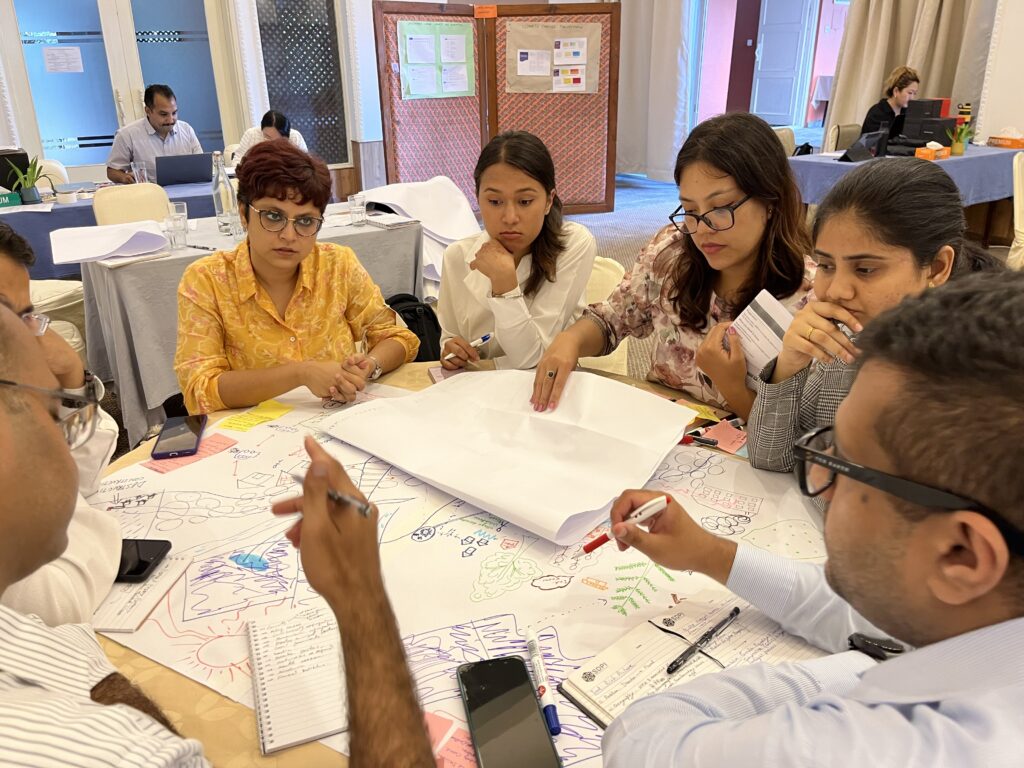
The Nepal event was a good chance to build on Foresight4Food’s capacity development experience in Kenya, Jordan, Bangladesh, and Uganda. These are focus countries for the Foresight for Food Systems Transformation (FoSTr) programme, supported by the International Fund for Agricultural Development with funding from the Dutch Government.
While food issues were only part of the focus of the workshop, the issues raised during the week yet again highlighted that the way food is consumed and produced is central to all development issues. Migration, climate adaptation, equitable livelihoods and managing disasters are all interconnected with agrifood systems.
What was covered in the training workshop?
During the week, the participants worked through the four main phases of the Foresight4Food Framework:
- Scoping the process
- Mapping the system
- Exploring future scenarios
- Mobilising for systems change

For each phase, participants were introduced to background concepts and theory, and relevant participatory foresight and systems thinking tools. Rich pictures, drawn by participants to illustrate the whole system, is always a favourite. Other tools we worked with included horizon scanning of future trends and uncertainties (guided by the PEESTLE acronym), data exploration, causal loop diagrams, scenario development, visioning, back casting and conceptual modelling of systems.
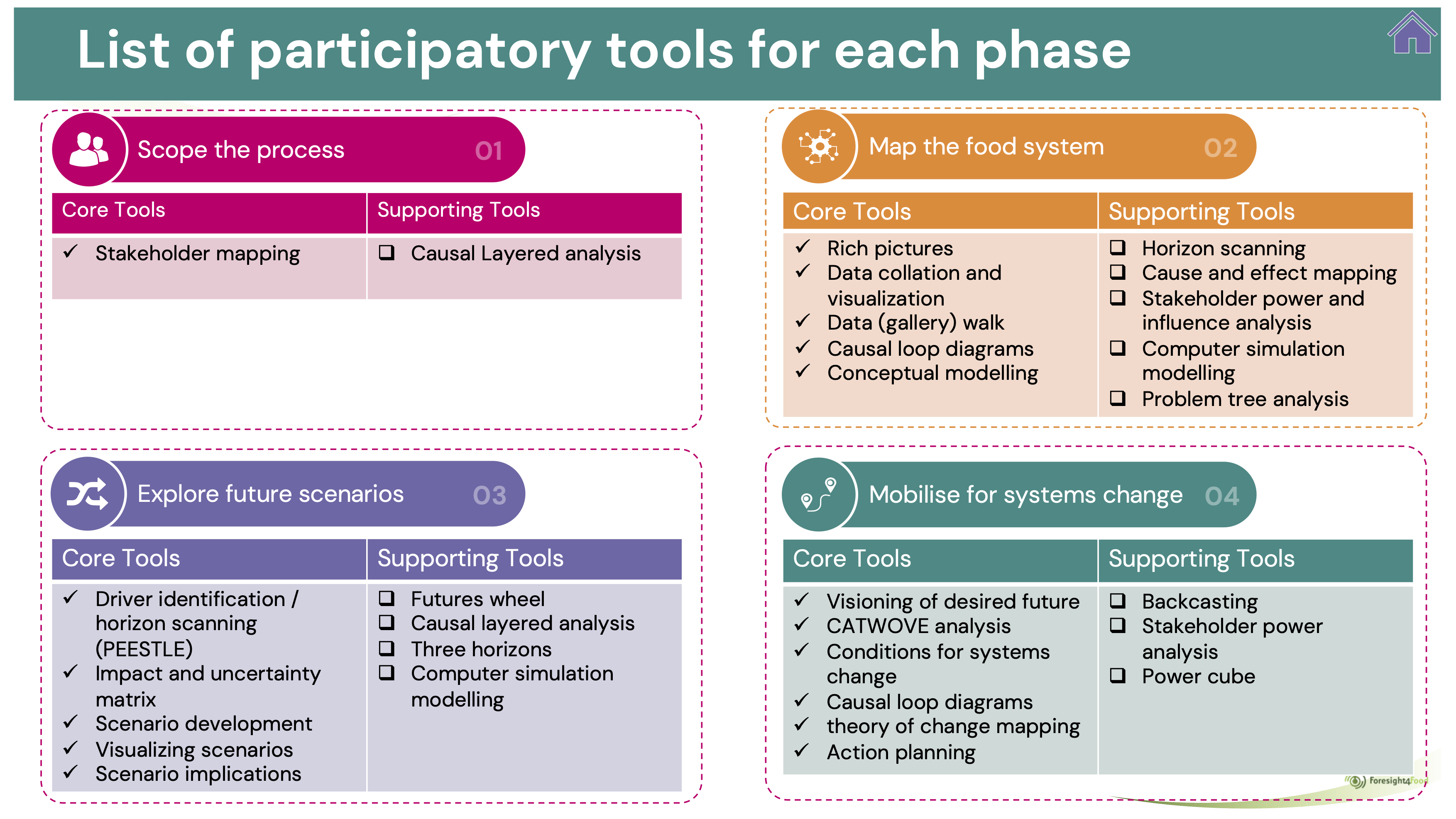
We discussed how change happens in complex adaptive (human) systems. The systems change “triangle” helped thinking about the role that mindsets and different forms of social and political power play in enabling or constraining change. The importance of bringing a gender equity and social inclusion (GESI) perspective to foresight was highlighted.
Participants applied their learning directly to the issues of climate adaptation, pastoralism, migration, and disaster preparedness.

The need for foresight
The global polycrisis is having a big impact on the Himalayas. The confluence of climate change, conflict, disease risk, inequality, biodiversity loss and geopolitical instability are bringing high levels of uncertainty and turbulence for citizens, businesses and governments across the region. For example, the melting of glaciers and the impact of extreme rainfall has profound implications for life in the mountains as well as for the billions of people who depend on the river systems that flow out of the Himalayas.
The Himalayas sit in the middle of a region with significant political tensions and shifting powers, which has major implications for the collaborative governance needed to effectively respond.
Foresight for systems change can help communities, organisations and governments better anticipate future risks and reimagine the future, so as to be more adaptive and resilient.
Thinking ‘out of the box’ – Foresight or “shortsight”?
Challenging discussions emerged during the week about how to ensure that foresight processes don’t just end up with the same old stuff – “old wine in new bottles”. To avoid this, we explored the need for “out of the box” thinking. This means looking for weak signals that might indicate a coming disruption, challenging assumptions about the future, bringing different perspectives to the table, using creative techniques to imagine radically different futures, and using the insights of “futurists”. A comprehensive horizon scanning process that explores mega-trends, trends, weak signals, critical uncertainties and wildcards helps to ensure foresight rather than “shortsight”.
Beyond tokenistic stakeholder participation
Across the Himalayas, it is local communities, local government and local businesses who must cope with the direct impact of floods, extreme heat, price fluctuations or disease outbreaks. Time and again participants returned to the importance of engaging local stakeholders to understand the challenges, and to generate pathways for greater resilience.
The discussion led to a shared understanding that this kind of participation from stakeholders requires genuine and open dialogue, made possible by using participatory workshop tools and techniques. However, all too often stakeholder engagement processes, when they do happen, fall back to formalised meeting structures, with speeches and presentations by “important” people, with little or no use of the sort of participatory analysis and dialogues tools participants engaged in during the training week. Advocating for effective, participatory and transformative stakeholder engagement processes is an obvious role for ICIMOD.
Institutional barriers to foresight and systemic practice
At the end of the week participants explored how to use foresight and systems thinking and practice in their own working context. Then some of the realities hit home.
Funders and donors often still force very linear, short-term and inflexible modes of programme design and management. Policymakers struggle to work effectively in a cross-ministerial way. People who see themselves as “senior” resist rolling up their sleeves and actively engaging in participatory processes with other stakeholders. Response strategies often stick to the safe space of technical analysis and technical solutions ignoring how mindsets and power structures block transformational change.
These are challenges that organisations like ICIMOD and initiatives like Foresight4Food need to help tackle if foresight is to have a real impact on policy and local action.



Cultivating a cadre of foresight and systems change practitioners
Participants recognised there is a limited number of practitioners/professionals across the region who have the knowledge, skills and experience to effectively design and facilitate foresight and systems change processes. A big effort is needed to create a cadre of practitioners who do have these capabilities.
To tackle this gap, governments can develop foresight units, universities could make futures literacy and systems thinking part of their curriculum, and development organisations need to in invest more in such human capabilities.
Way forward
On the last day of the workshop, the “collective intelligence” of participants was used to start framing a new horizon scan for the region that could follow up on the highly influential 2019 HIMAP report on the region.
Participants left with many practical ideas of how they could apply the foresight thinking and tools directly to their work.
For ICIMOD and Foresight4Food hopefully, this was just the start of collaborating to strengthen regional capacities for foresight.
The energy and commitment of participants were astounding, especially given long days of challenging discussions.
All in all, it was a super inspiring week – giving hope that with committed people like those in the workshop, supported by organisations like ICIMOD, we can together create a more resilient and equitable future.

By Jim Woodhill, Lead Foresight4Food Initiative
Why do we need to transform our food system and how can foresight help?
The way food is consumed and produced is central to the polycrisis afflicting today’s world – said Ravi Khetarpal (APAARI), Amina Maharjan (ICIMOD), and Patrick Caron (University of Montpellier) in their keynote presentations at the 4th Global Foresight4Food Workshop.
The Foresight4Food Initiative held its fourth global gathering in the beautiful setting of BCDM Savar, Dhaka from June 3 to 7, 2024. Over 120 foresight practitioners from across 22 countries came together to share ideas and discuss the latest thinking on applying foresight to the challenges of transforming food systems. The event was hosted by the Government of Bangladesh and the Global Alliance for Improved Nutrition (GAIN) Bangladesh, with support from the Food and Agriculture Organization (FAO) and the World Food Programme in Bangladesh.
In a highly interactive week, participants engaged in a masterclass on foresight approaches, shared their experiences and lessons, heard from thought-leaders on food systems and foresight, and identified ways of strengthening foresight practice in their own countries and regions.
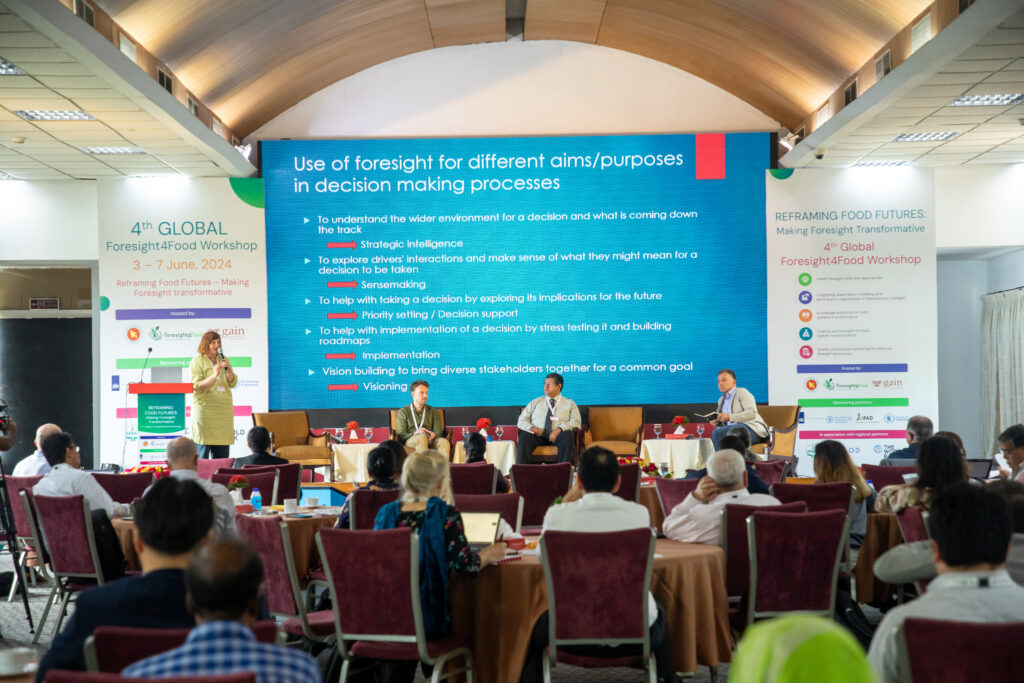


What does the future hold for our food systems?
Feeding the world contributes over 30% of greenhouse gases, and without change increasing population and wealth will drive this even higher. Meanwhile, diets are changing, often towards more unhealthy options. It is estimated that, by 2035, diet-related poor health could cost the global economy about 3% of GDP annually: this is the same negative impact that COVID-19 had on the economy. Environmentally, land use associated with food production is the main reason for the world’s massive loss of biodiversity and collapsing ecosystems.
And all of this is set against a background of increasing geopolitical tensions, and uncertainties for trade and access to resources.
As discussed during the different workshop sessions, foresight helps to understand the longer-term consequences of these trends, and the risks of “business as usual”. Even more importantly, participatory foresight and scenario development engages stakeholders in imagining how the future for our food systems could be different, in order to achieve sustainability, equity and resilience.



Highlights of the week included:
- Sixteen case studies on the use of foresight across Africa, Asia and the Middle East shared by participants – offering a wealth of insights, lessons and inspiration.
- Senior-level engagement from the Government of Bangladesh with insight into how foresight is seen as a key tool for helping to achieve their goals for food systems transformation.
- A deeper look at simulation modelling for foresight, and how a combination of qualitative and quantitative approaches can bring a range of important insights.
- Reflections on ensuring foresight processes are inclusive and consider gender dynamics.
- Six thematic sessions on cutting edge foresight issues which helped in mapping out a forward agenda for Foresight4Food.
- Strategic sessions on knowledge platforms and financing of food systems.
- Field trips where participants used insights from food system issues in Bangladesh to stimulate discussion on the future of the food system and sharing of cross-country lessons and experiences.
From my perspective, the key takeaways from the week were:
- The value of connecting foresight with a deeper understanding of the political economy of systems change, which is needed to help tackle the structural barriers to transforming food systems.
- Recognition of the critical importance of effective multi-stakeholder processes at national and local levels in driving food systems change, and the value of the foresight for systems change approach in supporting such processes.
- The necessity of increasing and reconfiguring investments in food systems and the need for this to be informed by the longer-term perspectives that foresight can bring.
- The value of integrating participatory foresight processes with quantitative modelling and use of data, while realising the constraints of limited food systems data at national and local levels.
- The importance of having foresight units and processes institutionally embedded in government, with a mandate and scope to challenge policy assumptions.
- A recognized need and growing demand for enhancing the capacities of policymakers, researchers and think tanks/consultants to design, facilitate and use foresight processes.
Participants left highly motivated to take forward the foresight work they are involved in and to help support the Foresight4Food network. The event ended with strong calls for the network to collaborate in helping to set up regional foresight support hubs across different continents.
By Bram Peters
The Foresight4Food FoSTr team has just returned from an active and productive trip to Kenya, despite the challenging political situation in the country. From our perspective, this highlights the need to adapt to turbulence and to use foresight to build resilience for Kenya’s food system.
From June 19 to 26, together with my team members including Jim Woodhill, Herman Brouwer, and Wangeci Gitata-Kiriga we conducted a range of food systems foresight workshops in Nairobi and Nakuru with a wide range of national food systems stakeholders. Here is a brief update on the action.
Navigating turbulence
On the morning of June 19, Foresight4Food, together with partners ILRI–CGIAR, Results for Africa Initiative and University of Nairobi, organised two sessions in Nairobi. The interactive breakfast session was all about ‘Navigating agri-business in turbulent futures’. The session was co-hosted by IFAD Kenya and was attended by a range of private sector associations, business support services, innovation facilitators and impact investors.
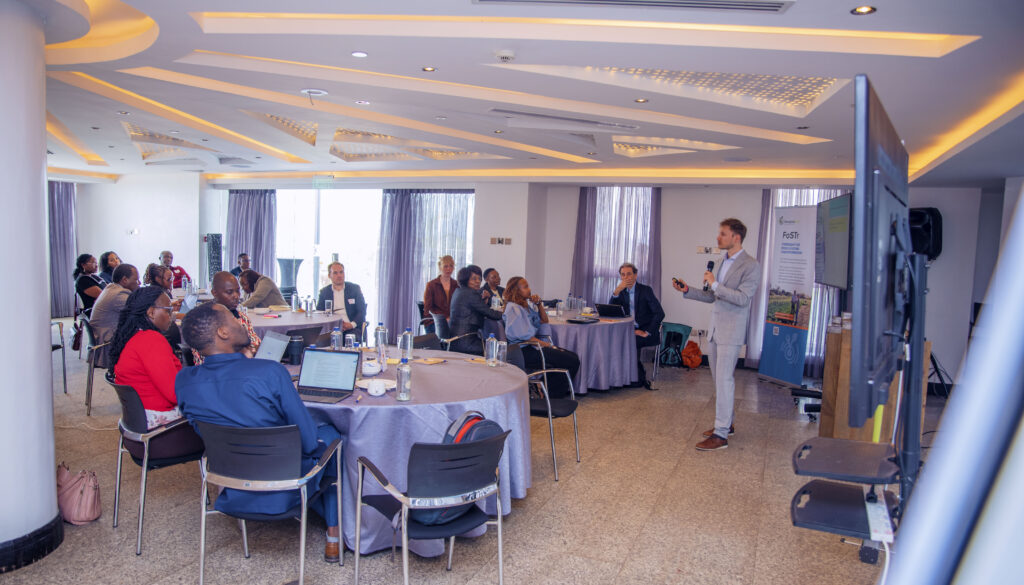
The focus of the meeting was to introduce the topic of foresight in relation to agribusiness in Kenya, share some of the scenarios that were developed in the context of Nakuru, and discuss the implications of different futures of the food system. Participants were shown five different scenarios of how the food system might look in 2040 in Nakuru and were invited to think through and discuss the implications of these scenarios.





With a strong presence and involvement of leaders from various private sector associations such as the Agriculture Sector Network (ASNET) of the Kenya Private Sector Alliance, the discussion invited stakeholders to reflect not only on trends and uncertainties emerging in Kenya, but also how their own businesses are preparing for the future.
Supporting the pathways for food system transformation
In the afternoon of June 19, the FoSTr team organised a national update session on the progress of FoSTr since June 2023. The session was attended by many individuals from the morning session, as well as representatives from government, civil society and research organisations. The FoSTr team presented the latest updates, including the launch of a ‘Kenya Food Systems Mapping Report’, and with a collection of scenarios for the Nakuru food system.

With a special presentation by the Ministry of Agriculture and the Food Systems Technical Working Group and special remarks from IFAD on the 3FS tool, it was discussed how a wide range of ecosystem support initiatives are buttressing the national food systems transformation pathways in Kenya. The approach by Foresight4Food to engage with two counties, Nakuru and Marsabit, and to build on Bottom-up initiatives showed how our approach complements the ongoing national-level initiatives.
Systemic Theory of Change
From June 19 to 21, the Foresight4Food FoSTr team facilitated a 3-day workshop for the inception phase of the new Netherlands-funded, World Food Programme and UNESCO on ‘Sustainably Unlocking the Potential of Lake Turkana. Stakeholder representatives from the Lake Turkana region (both on the Marsabit and Turkana sides of the lake) gathered in Nairobi to engage in a shared analysis of the complex food system and co-create the high-level focus of the programme.
The Turkana Lake food system is highly complex, with high food insecurity, vulnerability to climate change and conflict, and many cultural dynamics around pastoralist and fisheries livelihoods. Finding market opportunities and strengthening resilience is not easy, and requires a different way of working. Using the Foresight4Food approach, and building on 6 scenarios that were developed in previous workshops in Marsabit and Turkana, stakeholders explored what might need to be done to understand systemic risks and how lasting opportunities can be triggered.



Preparing a Systemic ToC is all about analysing the context, articulating the transformations needed in light of various future scenarios, and developing the building blocks for action. The building blocks include pathways, processes and partnerships. Through many interactive discussions and exercises, the stakeholders conducted value chain mapping of the fish value chain, CATWOVE for articulating systemic change narratives, and Causal Loop Mapping.
Manifesto for Change for the Nakuru Food System
On June 24 and 25, the FoSTr team including partners ILRI-CGIAR, Results for Africa Initiative and University of Nairobi once again visited Nakuru, now to explore systemic change pathways. As we already noted from previous workshops, the food system of Nakuru County is full of potential, as Nakuru’s natural resources are rich and a wide range of agricultural value chains are represented. However, challenges related to food and nutrition security and environmental sustainability exist. Trends of climate change, unhealthy diets and land fragmentation are appearing. The future holds many uncertainties. In order to future-proof the food system, it is urgent that investments are made to further enhance the resilience and sustainability of food and agriculture in Nakuru.



Since November 2023, a diverse group of more than 40 different stakeholders from Nakuru county have been coming together to consider the future of food system, supported by researchers and facilitators of Foresight4Food. This inclusive group looked at the challenges and opportunities for food and agriculture today and how they might evolve in 10-15 years. Food system analysis, an assessment of drivers and trends relevant to Nakuru, and 5 scenarios were developed by this group.
During these two days, stakeholders from Nakuru engaged in scenario interpretation and Causal Loop diagramming to come up with key pathways to kickstart food system transformation in Nakuru. These outputs culminated in a Manifesto for Change: a vision for the desired future for Nakuru’s food system and a range of possible pathways that can set us in that direction, while preparing us for a range of uncertainties. The Manifesto calls upon all stakeholders to join and align their actions, and intensify collaboration to transform Nakuru’s food system so that it can feed its people nutritiously; advance economic development; restore balance with nature; grow in-county revenue and eventually GDP growth for Kenya.
By Zoe Barois
Over the past year, the Foresight4Food Foresight for Food System Transformation – FoSTr team and our country partners have begun a foresight process in Jordan, Uganda, Kenya, Bangladesh, and Niger to support national food system transformation. As an initial step, a collective understanding of the food system in different contexts was needed. Hence, the Foresight4Food team in collaboration with our facilitators and research partners in each focus country, created comprehensive food systems reports mapping the dynamics, trends, drivers, and activities within the food system.
Being a lead on food system mapping, I’m sharing my reflections on the process in this blog.
We started with a scoping phase using the Foresight4Food foresight framework, which allows for flexibility and contextual adaptation. This phase involved identifying key stakeholders, understanding their interests, and assessing current and future concerns.
Our next goal was to foster a shared understanding of the food system’s key dynamics, outcomes, drivers, and activities to identify trends and uncertainties. This collective understanding forms the foundation for a participatory process using foresight and scenario analyses to support meaningful food systems change.
The second step, system mapping, was done in collaboration with country facilitators and research teams. We used the Foresight4food framework to identify key food system outcomes, activities, and drivers, considering their interaction with the broader environment. Data were compiled from national and global sources and generated through participatory workshops.
In addition to providing an overview of current status and trends, we conducted a deeper analysis using causal loop diagrams created with research partners during workshops. This approach helped identify trade-offs and synergies, informing actions to improve food system outcomes. We also noted recurring patterns that affect feedback loops, further clarifying the system’s structure.
These reports offer an initial snapshot of the current food system status and are intended to inform a more comprehensive foresight process. As the dynamics, trends, drivers, and activities within the food system continually change, these reports welcome ongoing reflection and discussion.





Read and download reports
The global food system needs to be transformed. It needs to deliver better health and improved livelihoods while protecting the environment and minimizing negative social impacts.
However, there are many interconnected factors playing a role. Food Systems are complex adaptive systems which require a deep analysis of their various driving forces and dynamics. They are shaped by a multitude of interconnected factors or drivers, some well-defined, others with a lot of uncertainties with them. A recent study by Forsight4Food identified the most critical drivers of the global food system as described by a set of 19 recent foresight reports. It was not easy to define and categorize these very drivers, and we will also discuss these challenges in this blog.
The Entangled Web of Drivers
Many studies, from the 2003 Millennium Assessment report to FAO 2022 have defined what is a ‘driver’. But the challenge is the lack of a universally agreed-upon definition for a driver. This means that categorizing these drivers is problematic. For instance, they can be classified based on their relationship with other drivers (direct or indirect), external factors (like PESTLE analysis- Political, Economic, Sociological, Technological, Legal and Environmental), or the extent of our knowledge about them (known knowns or unknown unknown).
What makes it even more intricate is that, due to the systemic nature of the food system, its nutrition, environmental condition, and economic development outcomes feedback indirectly becomes driver themselves. This creates feedback loops that complicate pinpointing which drivers are truly direct and which are indirect. Ultimately, it depends on the specific part of the system you’re focusing on. This is nicely depicted in the FAO’s food system diagram, however, it does not show the interconnections between different factors which is what needs careful consideration.
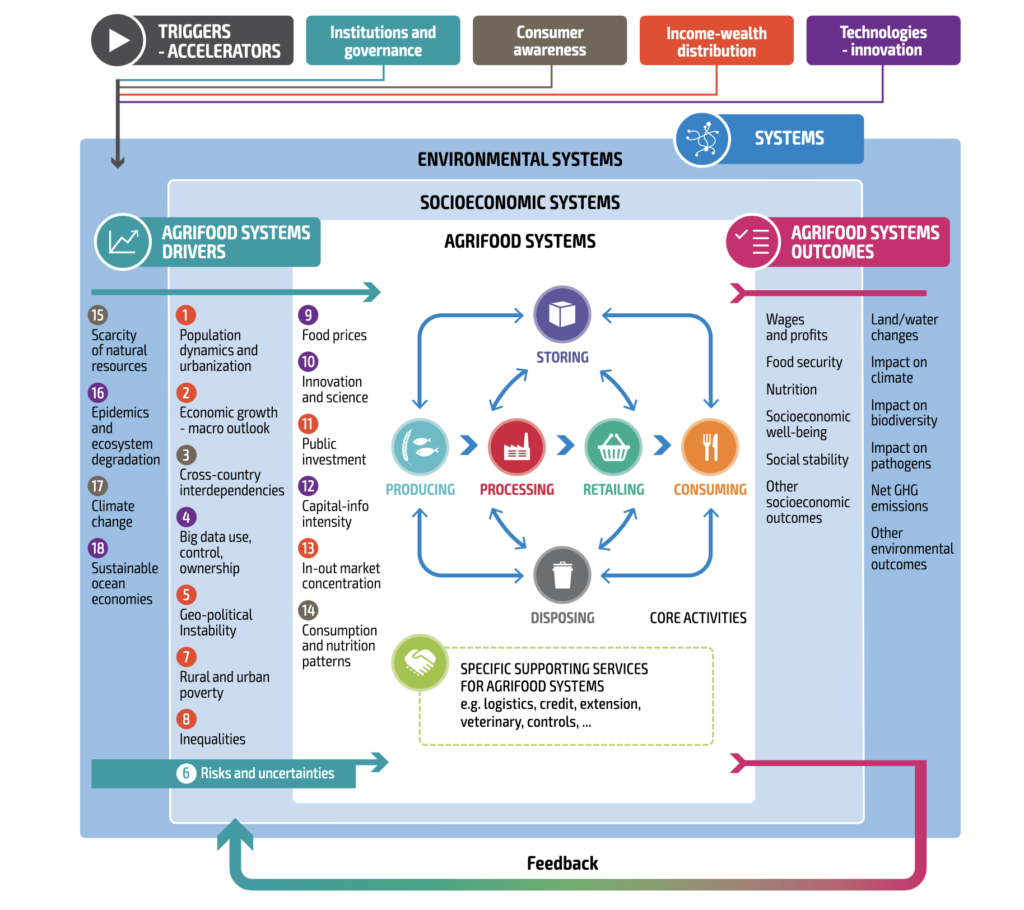
Source: FAO 2022
Here’s another layer of complexity: There are “known knowns” drivers like climate change and population growth and many models have been developed to understand the future trend. Then there are drivers such as government interventions (trade policies and subsidies) which is undoubtedly an important driver, but predicting the future impact of specific interventions is challenging. Similarly, we understand that diets are shifting towards more protein, but whether this trend holds true depends on the specific scenario we’re considering. These are “known unknowns” – we know they exist, but their future impact is a mystery. But the complexity is even deeper: “unknown unknowns”. Take the influence of social media on food choices. This is a relatively new area of study, and its full impact on the food system remains unclear. There can be overlaps in any type of categorisation system. Therefore, it is important to involve experts at this stage.
Identifying the Critical Few
The next hurdle is identifying “critical drivers” – those with the most significant potential to impact the food system. These drivers can influence various stages through established historical trends or emerging uncertainties. A key challenge lies in determining their relative importance across diverse contexts, often depending on stakeholder perspectives. For instance, immigration policies can have a significant impact on agricultural workforces in some regions. Incorporating stakeholder consultations is crucial to prioritize the most impactful drivers in these specific contexts.
Keeping the Conversation Open
It’s vital to remember that the impacts of drivers manifest differently across various socio-economic settings and among different food systems stakeholders. Highlighting the context in which a driver is critical helps us develop more targeted solutions.
We must also acknowledge that new or emerging drivers with unclear trends can also have profound impacts. For example, as mentioned earlier, the role of social media in influencing food choices is a relatively new area of study.
Therefore, the conversation around identifying critical drivers needs to be open to periodic updates. As we uncover new information and witness the emergence of new drivers, we can refine our understanding of the food system and adapt our strategies accordingly.
Future Trends and Projections
The future trajectory of these drivers is influenced by various factors, both internal and external to the system. Climate change, consumer behaviour, and technological advancements all play a role in shaping the path ahead. These complexities of cross-impacts create uncertainties about the future, often interpreted through different assumptions in various projections.
Many reports from IPCC, FAO and UNDP present some of the trends and projected trends around food system drivers. But these vary due to the underlying assumptions. Moreover, deciphering these projections can be challenging due to two key factors: 1) varying timescales and 2) diverse representations of what a sustainable food system actually looks like. However, by delving deeper into these assumptions and comparing them, we can gain a more comprehensive understanding of the possible futures that lie ahead.
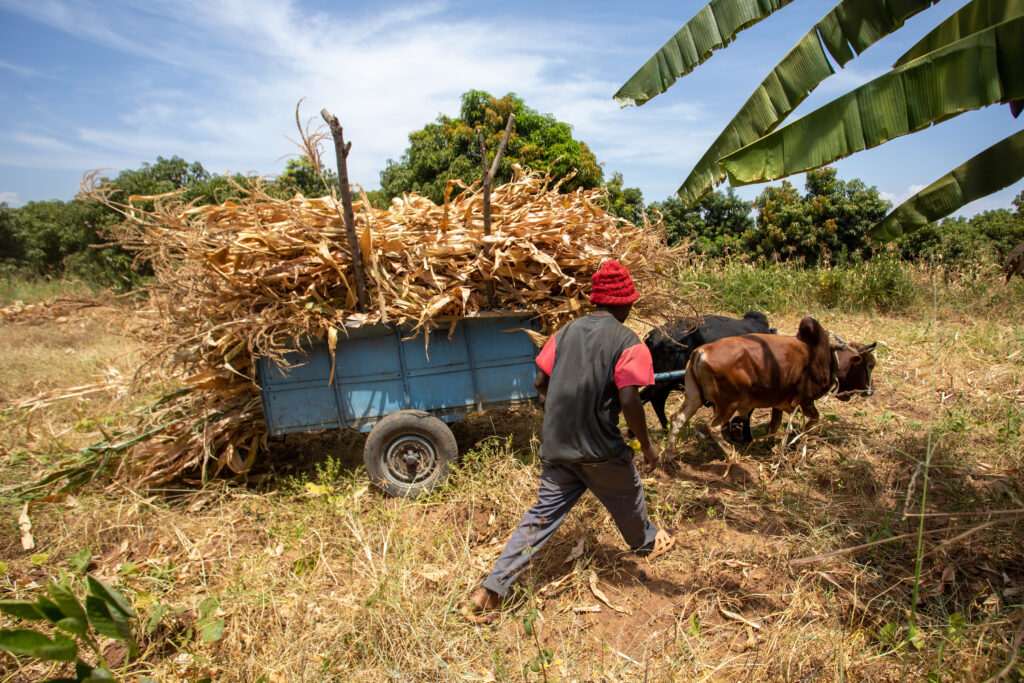


What we found…
The review of recent studies on food system drivers revealed a mix of established and emerging influences. We categorised drivers using the known-knowns and known-unknowns classification. Long-standing factors like demographic changes, climate issues, technological innovation, resource efficiency, socio-economic inequalities, government interventions, health considerations and level of connectivity continue to shape food systems, while new drivers such as the rise of e-commerce post-COVID-19, concerns about power imbalances in food value chains, labelling and packaging, data ownership issues, the role of indigenous knowledge, labour migration policies and perceptions around vegan and vegetarian diets are gaining importance. The relevance of these drivers varies based on stakeholder perceptions, indicating the diverse issues decision-makers must consider for effective management and adaptation.
The review also noted varying levels of uncertainty associated with these drivers. Established drivers, such as demographic trends, have narrower uncertainty ranges due to extensive research, leading to more consistent projections. However, differences in time frames, methods, and assumptions among studies complicate direct comparisons of quantitative trends. Emerging drivers, like government interventions and social media’s influence on consumer behaviour, exhibit broader uncertainty ranges and diverse trend directions, making them particularly significant for developing future scenarios. Our upcoming report will discuss these critical points in detail.
Conclusion
Transforming global food systems to deliver better outcomes is a complex and urgent challenge. Understanding the critical drivers shaping these systems, both well-known and emerging, is essential for creating the societal understanding and political will needed for meaningful change. Just as a map evolves with new discoveries, our understanding of these critical drivers needs constant refinement. Through ongoing research, collaboration, and open communication, we can navigate the complexities of the food system and support targeted solutions towards a more sustainable food system.
The preparations for the 4th Global Foresight4Food Workshop are well underway. A diverse group of participants are expected to join and use this opportunity to share their ideas and insights as well as connect with a growing community of foresight practitioners. In regard to this, we asked Dr. Rathana Peou Norbert-Munns, Sustainable Development, Agrifood System Policies and Climate Foresight Planning Specialist at FAO and a valuable member of the Foresight4Food steering group to share some thoughts and her expectations from the workshop.

The biggest challenge our world is facing that keeps me up at night…
If I had to pinpoint the most significant challenge, it would undoubtedly be climate change. However, as a foresight planning specialist, I’d say that a forward-thinking planning approach helps various stakeholders recognize not only the widely acknowledged issues but also those that are just beginning to emerge, the so-called early signals. These insights enable us to map out risks across multiple time horizons and envision plausible futures and encourage us to rethink our current actions and adopt innovative approaches which are urgently need it. Ultimately, while these concerns sometime disrupt my sleep, it definitely fuels my daily actions with a clear, long-term vision for sustainable change.
What I look forward to in the 4th Global Foresight4Food workshop
My expectations are set high to leverage the tool of Foresight for Food System Transformation effectively. In a global polycrisis, there is a pressing need for innovative and strategic thinking to guide decisions that ensure sustainable food systems.
This year’s theme of the Foresight4Food Global Workshop captures the essence of what we aim to achieve: a shift in how we envision and shape the future of food systems. It promises to be a crucial platform for sharing insights, fostering collaborative efforts, and enhancing the capabilities of practitioners through knowledge exchange and community building. It is an opportunity to connect with a diverse network of experts and stakeholders, all driven by the common goal of transforming food systems for a better future. By creating a safe space for discussion and reflection, the workshop will challenge us to consider innovative accelerators for our work and identify necessary changes in our approaches.
“This year’s theme of the Foresight4Food Global Workshop captures the essence of what we aim to achieve: a shift in how we envision and shape the future of food systems.”
The workshop will also allow us to critically assess vested interests within the food systems, ensuring that our solutions are inclusive and equitable, truly embodying the principle of leaving no one behind.
On a personal level, I expect that the insights I’ll gain from the workshop will be integral to refining approaches developed for key programs in the Asia Pacific region. By learning the latest foresight methodologies and emerging trends, I aim to reflect with an increasing community of practitioners and find avenue to collaborate more effectively with stakeholders to implement resilient and sustainable food policies and practices.
Some ways to make the workshop more effective, my two cents
To ensure the workshop has a lasting impact on cross-sector collaborations and actions towards food system transformation, Foresight4Food must foster an environment of honesty where participants feel secure in openly sharing both challenges and innovative ideas. Encouraging creative and bold thinking is essential, as it will drive the development of groundbreaking strategies that transcend traditional sector boundaries and catalyze meaningful changes through transformative foresight.
by Bram Peters
As a part of the FoSTr programme, the Foresight4Food team organized the “Exploring Alternative Futures for Jordan’s Food System” workshop in Amman, Jordan that brought together food systems stakeholders in Amman to discuss the future of Jordan’s food security. Here are some of the observations and insights from the event.
With themes of resilience, adaptation, action, and collaboration, participants engaged in scenario planning and back-casting exercises to anticipate challenges and shape future outcomes. Key uncertainties like water availability, healthy diets, regional trade, and business structures were explored through four scenarios set in 2040. These insights, supported by quantitative modeling, fostered rich discussions about desirable futures and the actions needed today to create a sustainable, resilient food system for Jordan.
During the workshop, colleagues from the University of Jordan and Jordan University of Science and Technology presented four policy briefs. These were: Food Loss and Waste, Water-to-Food Conversion, State of Smallholder Farming in Jordan and Malnutrition. Each policy brief captures the state of knowledge and offers recommendations to explore how to address these issues from a food systems perspective.
The FoSTr team introduced four critical uncertainties that will be highly important and uncertain to the long-term future of the Jordan food system:
- The extent of fresh water available to agriculture
- The extent to which healthy diets are adopted
- Level of ease of regional trade
- The type of business structure the food system will have
Each of these uncertainties was combined to offer four scenarios, taking place in 2040, up for discussion with the participants. Supported by insights from quantitative simulation modelling, the implications on food systems outcomes were explored in each scenario. Some scenarios described that the people of Jordan adopt healthy diets despite a challenging regional trade situation. In others, severe limitations on fresh water for agriculture were seen in combination with a highly corporate-led food system.
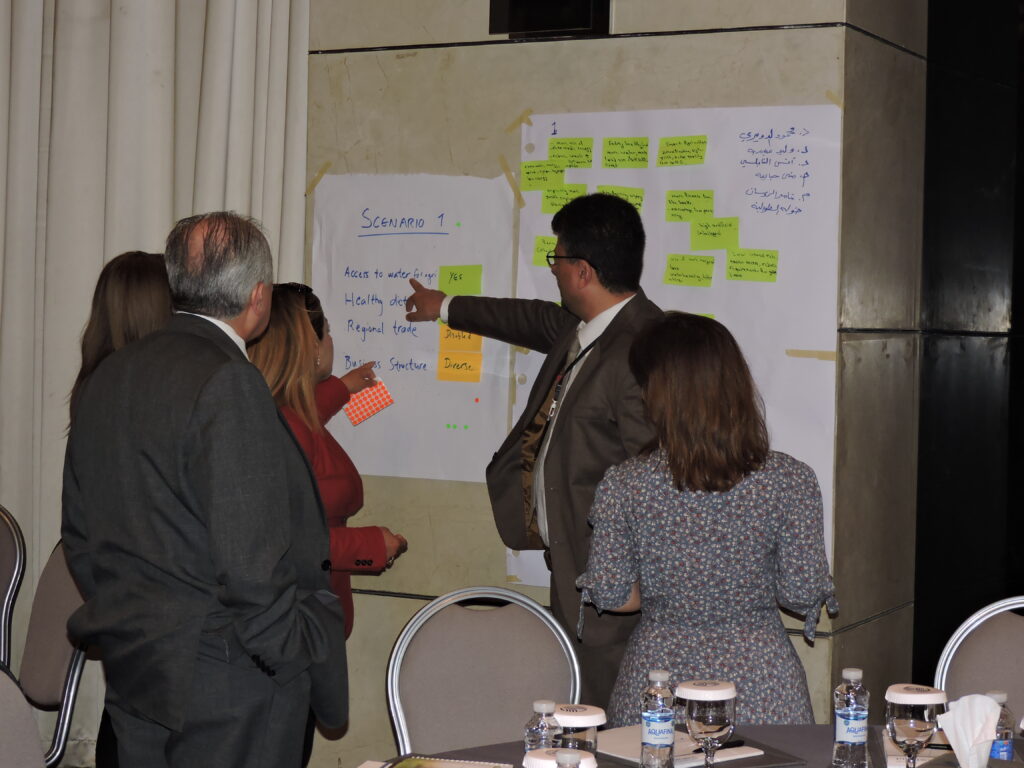


Additionally, the participants explored how that situation might look in each. These scenarios served to open up minds towards the possibility of different situations emerging in the future and highlight the need for anticipatory action and systemic change.
The scenarios led to a discussion of what might be the ‘most likely‘ and ‘most desirable’ scenarios for the Jordan food systems stakeholders. The outline of a desirable future, informed by trends and uncertainties, was formulated to serve as a guiding star. A back-casting approach was used to then explore what events and turning points might occur between 2040 and now to realise that desired future. Based on this timeline, stakeholders brainstormed a range of different actions and stakeholders which are needed now, to already start pushing the system towards the Desired Future.
Building on the encouraging shared co-ownership of the results of the workshop, the Foresight4Food FoSTr team will continue efforts to develop policy briefs, deepen the action areas that were developed, and support the Food Security Council of Jordan in proving the underpinnings for the ongoing work on national food systems transformation.

Foresight4Food is organizing its 4th Global Workshop in June titled “Reframing Food Futures: Making Foresight Transformative”. To raise the tip of the curtain on this exciting event, we have asked Mohammad Monirul Hassan, Foresight4Food Country Facilitator and Global Alliance for Improved Nutrition (GAIN) Advisor, to share some of his thoughts and expectations. Here is what he has to say:
As a food systems practitioner, what keeps me up at night
Bangladesh has made significant progress in food security and nutritional status over the past decade, with a growth rate of food production much higher than population growth. The country’s food grain production self-sufficiency has been sustainable and stable, and access to food has improved over time. However, the country still faces challenges in ensuring food and nutrition security for its growing population of around 170 million, projected to reach over 186 million by 2030.
The recent COVID pandemic and the subsequent Russian-Ukraine war have put enormous pressure on the food supply in the country, as Bangladesh is a net food importing country. We have achieved self-sufficiency in rice and some other products; however, the country is still dependent on wheat imports, edible oil, lentils, pulses, and spices. Due to the depreciation of Bangladesh’s Taka against the US Dollar, import costs have increased significantly which impacted the price of commodities both in the food and non-food sectors. The lower-income households are struggling to meet daily needs due to income losses and price hikes.

The recent COVID pandemic and the subsequent Russian-Ukraine war have put enormous pressure on the food supply in the country, as Bangladesh is a net food importing country. We have achieved self-sufficiency in rice and some other products; however, the country is still dependent on wheat imports, edible oil, lentils, pulses, and spices. Due to the depreciation of Bangladesh’s Taka against the US Dollar, import costs have increased significantly which impacted the price of commodities both in the food and non-food sectors. The lower-income households are struggling to meet daily needs due to income losses and price hikes.
As a Bangladeshi citizen and a food systems practitioner, a thought that concerns me is that the emerging negative trends and uncertainties like climate change, population growth, income inequality, agricultural labor scarcity, and barriers to access to safe and nutritious food may push back the decade-long achievement of the food and nutrition security of the country in the long run.
Climate change adaptation is the key priority in Bangladesh. Bangladesh is one of the most vulnerable countries in the world to climate change impacts. Developing climate-resilient technologies that exhibit tolerance to drought, flood, heat, cold weather, and salinity can help mitigate production losses caused by the frequent occurrence of extreme weather patterns anticipated due to climate change. Alongside conventional staple crops like rice, wheat, and maize, more focus is given to advancing technologies for protein-rich crops such as pulses and beans, as well as vitamin-rich fruits and vegetables. Enhanced breeds of cattle and poultry that possess the ability to endure harsh climatic conditions are being developed.
The focus is given to enhancing productivity through advances in crop, livestock, and fisheries management, either individually or in combination with genetic enhancements. Improved management methods in agriculture can enhance profitability for producers while also promoting sustainability by optimizing the use of inputs such as seeds, fertilizers, pesticides, and water, and lowering the environmental impact of farming. To improve the food and nutritional situation, more emphasis needs to be placed on coordination, enhancing partnership and policy coherence, and strengthening implementation means.
FoSTr’s support in Bangladesh’s vision of sustainable food systems
Food system transformation is high on the political agenda in Bangladesh with the formulation of the National Food and Nutrition Security Policy 2020, its Plan of Action (PoA) 2021-2030, National Agricultural Policy 2018, and Bangladesh’s contribution to the UN Food System Summit 2021 and the UNFSS +2 Stock Taking Moments (STM). Bangladesh has outlined its “Making Vision 2041: A Reality-Perspective Plan of Bangladesh 2041”, Dhaka Food Agenda 2041, Smart Bangladesh Vision 2041, and the Bangladesh Delta Plan 2100, which depict the country’s aspiration and preparation towards a developed nation.



To support that, the Foresight for Food Systems Transformation (FoSTr) program is providing a flexible decision-support facility to support Bangladesh with evidence-based foresight and scenario analysis that goes along the country’s vision to work towards sustainable food systems in Bangladesh.
As part of reporting to UNFSS STM+4 (2025) and fulfilling the Honorable Prime Minister’s commitment to UNFSS, foresight analysis of the food systems will complement the data, research, risk analysis, and scenarios development for the future food systems and provide necessary guidance for food systems transformation.
Expectations of the Foresight4Food Global Workshop experience
For this year’s Global Foresight4Food Workshop, the theme is “Reframing Food Futures: Making Foresight Transformative”. What I seek from this workshop is an opportunity for cross-country learning about using foresight tools, their drawbacks, and ways for improvement for better foresight analysis, as well as areas of collaboration, partnerships, and future investments for the country’s food systems transformation. I also think this will be a wonderful opportunity to showcase how Bangladesh is transforming its food systems with its various challenges.
From a personal point of view, I expect that the learning and insight of the workshop will help me understand the food systems transformation agenda in Bangladesh. It will also help me in policy advocacy in prioritizing areas and activities that build sustainable and resilient food systems.
Another aspect of the Foresight4Food Global Workshop that I hope for is that it will create space for highly interactive dialogue, igniting creativity and sparking actionable progress on the foresight agenda, offering cutting-edge updates on foresight practice and applying foresight to country realities.
The workshop will contribute to understanding how other countries are transforming their food systems, what works and what doesn’t, what matters most, and what supports are required, etc. The workshop will be a great opportunity where you’ll be able to build networks, partnerships, investment opportunities, and investment progress tracking and implementation. Moreover, the workshop will help governments reframe some of the initiatives and prioritize them based on the political economy contexts.
All in all, it will be truly exciting to see energetic participation from food systems researchers, practitioners, and government and private sector representatives gathered under one roof to talk about making foresight transformative.
By Bram Peters – Food Systems Programme Facilitator, Foresight4Food
In the north of Kenya, on the border with Ethiopia, the landscape is expansive and dry. Pastoralism is the main source of livelihood, but to the west of this landscape is Lake Turkana, one of the largest saline desert lakes of the world. Here communities engage, some productively and others reluctantly and out of desperation, in fishing.
In March 2024, the Foresight4Food FoSTr team traveled to the fascinating Kenyan county of Marsabit to facilitate a multi-stakeholder forum to support the co-creation of the new ‘Sustainably Unlocking the Economic Potential of Lake Turkana’ programme.
In Marsabit, stakeholders from around the Turkana Lake, including fishers, traders, service providers, county government technical officers, and non-governmental organizations, came together to analyze the context and co-create future scenarios and intervention areas for a new WFP and UNESCO programme, funded by the Embassy of the Kingdom of the Netherlands.
Together with the World Food Programme and the World Food Programme Innovation team, the FoSTr team held a highly interactive and productive three-day workshop. As most stakeholders mainly spoke Kiswahili, we switched to short presentations with much emphasis on interactive group work. On the first day, the workshop focused on contextual understanding of the Lake Turkana food system as well as the Marsabit county livelihoods, using the Rich Picture mapping exercise. Participants together drew the food system, the geography of the lake, but also the stakeholders, activities, key relations and dynamics.



On the second day, the groups presented their deep knowledge of the context to each other and elaborated on this. Workshop participants tackled key trends shaping the food and livelihoods system: groups discussed how various themes (for example: lake water levels, fish stocks to income sources, conflict, and education) changed over time and what they expect to happen 10 years into the future. Important in this discussion is their analysis of what driving issues would influence change in the future.

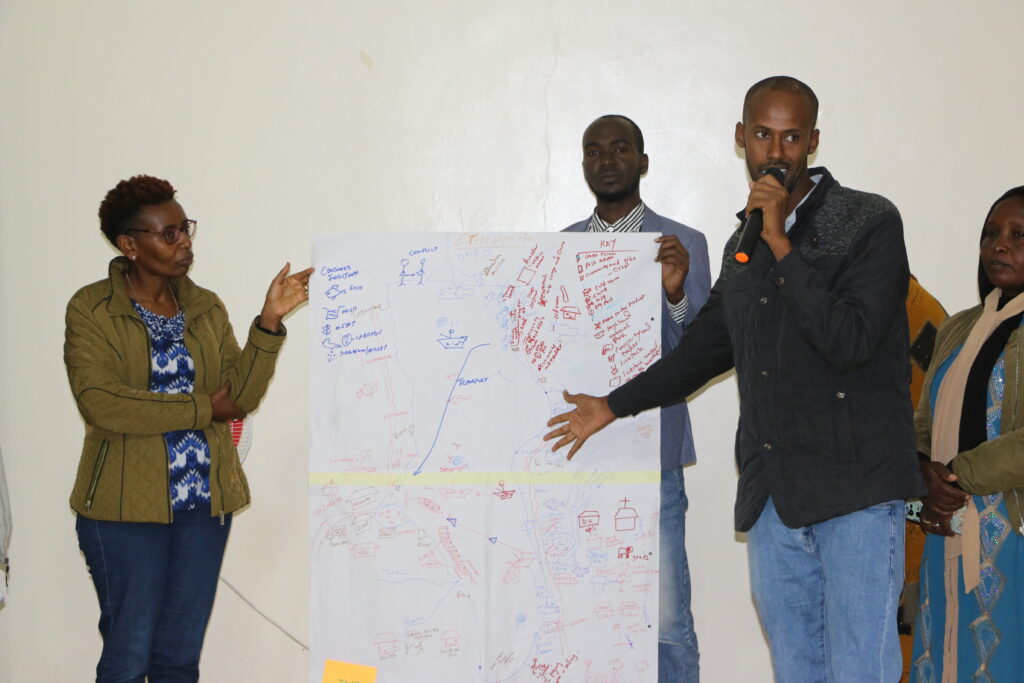

5 scenarios were created for the future regarding the fisheries sector and supporting livelihoods, as well as an in-depth discussion on key entry points for intervention in the system. These scenarios had names that described these futures succinctly:
- ‘Tumaini Paradiso’, a future with a growing fishing sector, inclusive benefit sharing and sustainable natural resource management;
- ‘No retreat, no surrender’, a situation in which the benefits of a growing fisheries sector are controlled by a few;
- ‘Short gain, long pain’, a scenario where the fisheries sector grows and livelihoods improve around the lake, but the environment is not maintained;
- ‘Gasping blue economy but others rise’, is a future where the fisheries sector remains marginal for communities, but other sectors are developed that also contribute to inclusive development and environmental sustainability
- ‘Darkness in life’, a bleak outlook where none of the envisioned sustainable economic development around the lake delivers and where climate resilience is low, and conflict is rife.


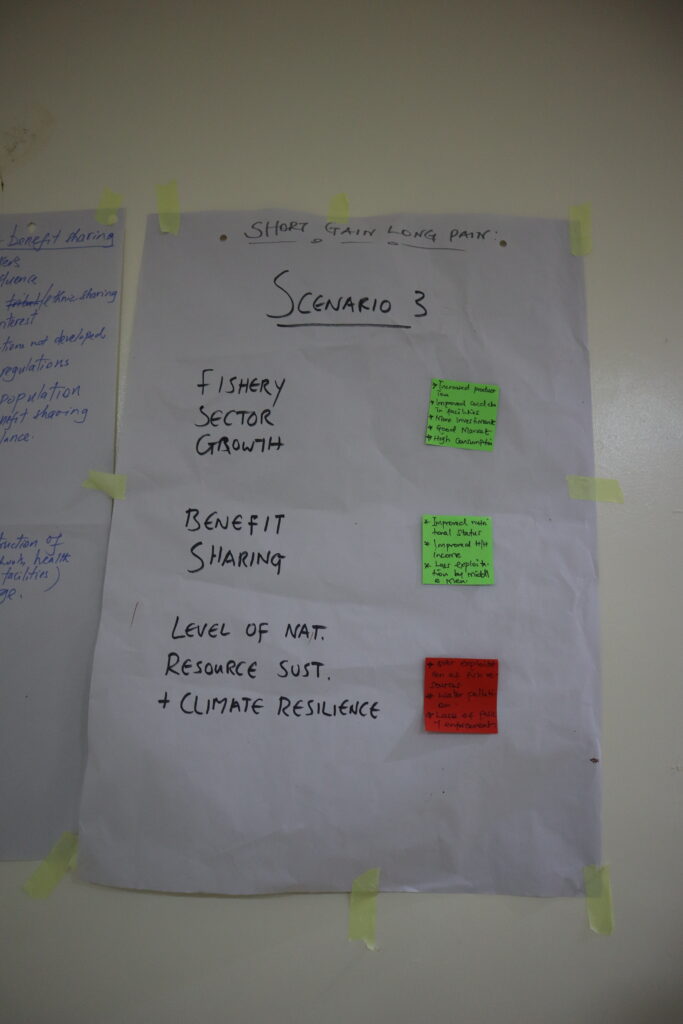


Different stakeholders participating in the workshop had different opinions on the likelihood of certain scenarios emerging. Some imagined the situation worsening, while a few viewed the future more positively. These reflections clearly showed a combination of outlook of participants as well as the signals they interpret from the current situation and the trends seen now. Interestingly, none of the stakeholders felt the ‘Paradiso’ scenario was likely, showing that the programme needs to be modest in its systemic ambitions, but also be ready to do things very differently. These scenarios showed what could become a very relevant frame of reference to the stakeholders as well as the programme implementors.
On the last day of the workshop, participants explored a common vision for the future, and how the food system is currently working. This led stakeholders to have a first try at exploring what is needed to change that system toward the common vision.

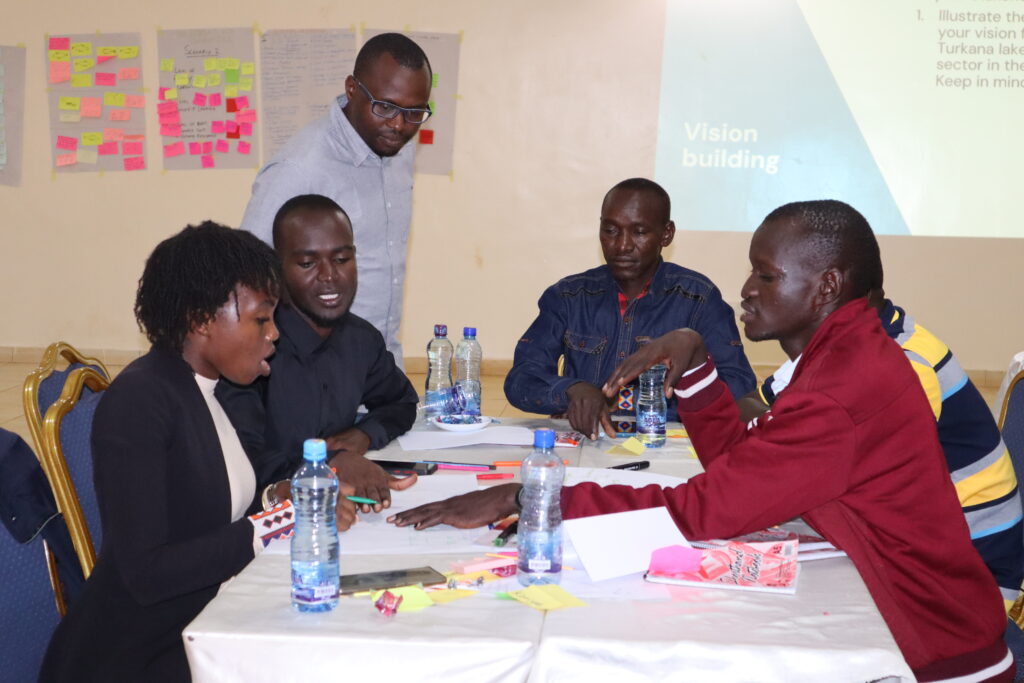

At the end of the workshop, I felt highly positive about these fruitful discussions that enabled participants to think about what might happen to the Marsabit food system in the years to come, and what factors would influence these changes. In addition to that, the insights gathered through the multi-stakeholder forum are expected to not only support the inception phase of the programme but will also support multi-stakeholder engagement throughout the programme.
The Foresight4Food FoSTr team will continue to support the World Food Programme team in realizing the ‘Sustainably Unlocking the Economic Potential of Lake Turkana’ programme inception phase. A follow-up workshop will take place in Turkana County from March 25 to 28, with stakeholders from that side of Lake Turkana.
By Jim Woodhill, Foresight4Food Initiative Lead
Last month (November 2023) I had the wonderful experience of engaging with over fifty young leaders from across Africa, joined by colleagues from Bangladesh, Nepal, and Jordan. We had all gathered in Naivasha, Kenya, to explore how skills in facilitating foresight can be used to help bring about food systems transformation.
The fascinating work these young leaders are involved in and their deep interest in understanding how to be more effective change-makers was truly inspiring. It was encouraging to see how valuable they found the foresight for the food systems change framework and the associated set of participatory tools for engaging stakeholders.
Participants all came with projects from their own countries where they are keen to use foresight and systems thinking to help facilitate change in food systems by bringing together different stakeholders. The participants were from diverse backgrounds representing policy, the private sector, NGOs, and academia.

A Guiding Framework: During the workshop we introduced participants to an overall guiding framework for facilitating foresight for food systems change. A range of participatory tools were used for systems analysis, development of future scenarios and exploring systemic interventions. To bring reality into the workshop, the Kenya horticulture sector was used as a case study for the foresight analysis. Participants spent a day visiting horticulture farms, packing and processing facilities and the local market. They explored with local stakeholders how they saw the future for the horticulture sector and the issues that “keep them awake at night”.

Visualising the system: The workshop was highly interactive with participants practicing in the facilitation of a range of participatory tools which can be used to bring stakeholders into dialogue around systems change. One of my favourite participatory tools “rich picturing”, which enables a diverse group of stakeholders to develop a shared understanding of a system by drawing it, was found by participants to be especially powerful.

Data-driven dialogue: To go deeper into the systems analysis it is valuable for stakeholders to explore the available data on key drivers and trends. Over 100 graphs visualizing key data points related to the Kenya horticulture sector and food systems at national, continental, and global scales were collated and posted around the walls. The participants then explored this data in groups of three and discussed its implications and how it perhaps challenged their existing assumptions.

Exploring the future using scenarios: Central to the foresight approach is developing a range of different plausible future scenarios (generally with a 10 to 30-year horizon) for how the system might evolve given critical uncertainties. Workshop participants did this for the horticulture sector, looking at factors such as how diets might change in the future, regional and global trading relations, severity of climate change, and the enabling policy environment for small-scale producers and the small- and medium-scale enterprises (SME) sector. The scenarios help to identify future risks and opportunities for different stakeholder groups and society at large. They also help to unlock creative thinking about how to “nudge” systems towards more desirable futures and away from less desirable ones.

The deeper issues of systems change: It is easy to talk about systems change. In reality trying to change systems bumps into all the difficult issues of vested interests, power relations, ideologies, and deeply held cultural beliefs. On top of this human and natural systems are complex and adaptive and behave in self-organising, dynamic, and often unpredictable ways. It doesn’t mean you can’t intervene to try and bring positive change. But it does mean that top-down, linear, and mechanistic models of change generally don’t work. The workshop engaged participants in deep and challenging discussions about what it means to be a leader of systems change. This included the need to be adaptive, how to create alliances for disrupting existing power relations, the importance of building relations between diverse stakeholders, and the importance of patience. Systems change often requires taking time to build the foundations for change without being able to know when circumstances might suddenly unlock opportunities for big steps forward.

Identifying directions for change and intervention options: Developing directions and pathways for systems change is the most difficult and challenging part of the foresight for systems change process. It is highly context-specific and requires a deep insight into the political economy of the situation. Cause and effect mapping, theory of change thinking, and causal loop analysis can all help in identifying opportunities for intervening which could help to drive systems change in desired directions. Bringing change will often require an integrated approach to technological, institutional and political innovation. During the workshop causal loop diagrams were used to explore possible entry points for shifting horticulture systems in ways that could improve health, livelihoods and the environment.

New friends, new networks and big ambitions: After an intense week of learning and sharing participants left inspired to apply the foresight approach back in their own work environment. New friends were made and there were clear calls to find mechanisms to support ongoing networking and peer support.

Many thanks to the facilitation and support team who made a fantastic week possible, Gosia McFarlane, Marie Parramon-Gurney, Kristin Muthui, Bram Peters, Joost Guijt, Riti Herman Mostert, and Abdulrazak Ibrahim. The event was made possible by support from the Mastercard Foundation.
More information about the Foresight4Food Framework of Foresight for Food Systems Change can be found on our website, and an updated approach paper will be published in January 2024.